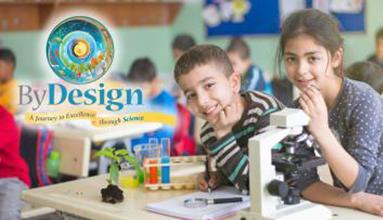 By: Elizabeth Kelsey, Kendall Hunt RPD Intern, with contributions from the writing team of ByDesign Science
By: Elizabeth Kelsey, Kendall Hunt RPD Intern, with contributions from the writing team of ByDesign Science
The tremendous power of a river is diminished when it is fragmented into little streams. However, when the streams are channeled together, it then can develop a deep flow. So it is with learning.
—Author and educator Ben Johnson
Cross-curricular learning is one of the most powerful ways educators can help students understand and retain information. By making connections to their daily lives and other areas of study, students give themselves more “hooks” for remembering concepts and make their schoolwork more meaningful.
Here are ten ways that the ByDesign Science curriculum leads students to explore educational areas beyond strictly “science.”
These features lead students to understand and recognize scientific vocabulary, cognates, and root words. They also include ideas such as word association games and additional activities for English language learners.
Example topics: other uses of words such as “cloud” (idioms, e.g., “on cloud nine”); Greek and Latin root words
Math in Science callouts present students with mathematical concepts in a scientific context. Weights and measures, basic mathematical operations, and ratios and probability are all included, with story problems that help students connect the concepts to the material in that chapter.
Example: Jake does 10 jumping jacks every morning for 5 days. How many jumping jacks does Jake do?
These spotlights direct students to Scripture passages related to the topics in the chapter. In making these explicit connections to Scripture, ByDesign establishes itself as not merely a science curriculum that coexists with religion. Rather, it is built on a firm religious base, a cross-curricular connection from which students benefit.
Example verse: 3 John 1:2 (“I wish above all things that you may prosper and be in health”) in connection with content regarding strong muscles and bones
Especially prevalent in our units on Earth and space science, the Science and Society feature draws a connection between science and our daily lives. These features engage students’ critical thinking skills and help them see how their actions affect the world around them.
Example topics: how people with motorized wheelchairs navigate daily lives, how urbanization leads to habitat loss
The History of Science features expose students to the advances in scientific knowledge over the course of centuries. They are able to appreciate the long process of scientific discovery, as well as understand their place in the cycle of human history and God’s creation.
Example topics: the history of human flight, discovery of x-rays, advances in weather prediction
These extensions show students how scientific concepts are applied to create new technology that makes our lives easier. Students learn how various technologies work and see the good they do in society, helping them realize the “real-life applications” of the content they are learning.
Example topics: bone loss among astronauts in space, pulleys, electric bicycles, ultrasound
The Careers in Science extensions offer students a glimpse of the many jobs related to science. Students learn about unique careers (such as fulminologists, who study lightning) and realize how some careers that may not seem “scientific” are actually very much so (musician, for example).
Examples: mechanical engineer, inventor, meteorologist, wetland ecologist, chiropractor
The People in Science feature introduces students to famous and influential scientists, many of whom are also committed Christians. In learning about these researchers, students gain an appreciation for the kinds of work scientists do and how that work can serve God and His creation.
Example: Dr. Larry Vardiman, who studies hurricanes to better understand the Genesis Flood
These two features work together to show students how what we know about the science of our bodies can help us to treat them better. They cover topics such as nutrition and physical safety and guide students to treat their bodies with the care and respect that God desires.
Example topics: heatstroke, sunburn, exercise, “Simon Says” bone identification game
Family Links encourage students to share with their family members what they learn, providing suggestions for family activities. By connecting the home environment with the classroom, students broaden their learning horizons and learn more as they become the “teachers” for their parents and siblings.
Examples: cooking a healthy meal with your family, finding ten simple machines in your home
Deepen your students’ learning through cross-curricular connections with ByDesign, our custom, comprehensive science curriculum for grades 1–8!
How have you seen cross-curricular learning enrich your students' knowledge?